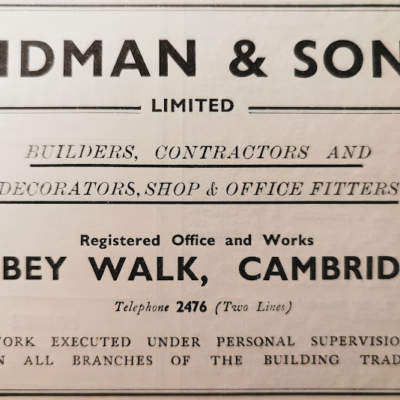Search by topic
- archaeology
- architecture
- bricklayer
- Building of Local Interest
- carpenter
- church
- crime
- dressmaker
- fire
- general labourer
- Great Eastern Railway
- listed building
- medieval
- oral history
- Public House
- Rattee & Kett
- Roman
- scholar
- school
- Then and Now
- tudor
- women
- work
- world war one
- world war two
Search by text
68 York Street
The Family of a Railway Goods Foreman
1881
Harry Hight, head, 26, 1855, printer, Hemmington [Hablets North?]
Mary A. Hight, wife, 24, 1857, Bury St Edmunds, Suffolk
Percy W. Hight, son, 11 months, Cambridge
1891
68 York Street was Uninhabited on the night of the 1891 Census.
1901
Thomas Tatham, head, 38, railway goods foreman, 1863, Bedford, Bedfordshire
Susan Tatham, wife, 37, 1864, Farcet, Huntingdonshire
Ellen G Tatham, daughter, 15, dressmaking apprentice, 1886, Stanground, Huntingdonshire
Joseph E Tatham, son, 11, 1890, Stanground, Huntingdonshire
Arthur E Tatham, son, 7, 1894, Cambridge
Alfred T Tatham, son, 2, 1899, Cambridge
1911
Thomas Tatham, 48, railway goods foreman, b. Bedford
Susannah Tatham, 47, b. Huntingdonshire
Joseph Eyre Tatham, 21, groceries & provisions shop assistant, b. Stoneground, Huntingdonshire. Joseph married Lydia Martin during the summer of 1918. The couple lived at 4 Stone Street from 1919 until 1966 at least. Buried in MRC with wife Lydia and her parents.
Arthur Edwin Tatham, 17, draper’s shop assistant, b. Cambridge
Alfred Thomas Tatham, 12, school, b. Cambridge
Susannah and Thomas have been married for 26 years, they have had five children.
Cambridge Independent Press 18 Jan 1918 – “PTE A E Tatham Cambridgeshire Regiment second son of Mr & Mrs Tatham, killed in action Nov 15th 1917.”
Sources: 1881, 1891, 1901, 1911 UK Census, Cambridge Independent Press, Mill Road Cemetery,
Contribute
Do you have any information about the people or places in this article? If so, then please let us know using the Contact page or by emailing capturingcambridge@
License
 This work is licensed under a Creative Commons Attribution-NonCommercial-ShareAlike 4.0 International License.
This work is licensed under a Creative Commons Attribution-NonCommercial-ShareAlike 4.0 International License.









